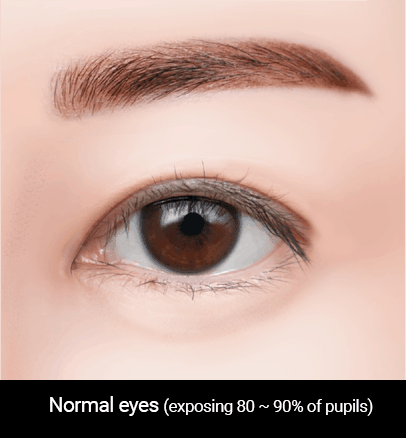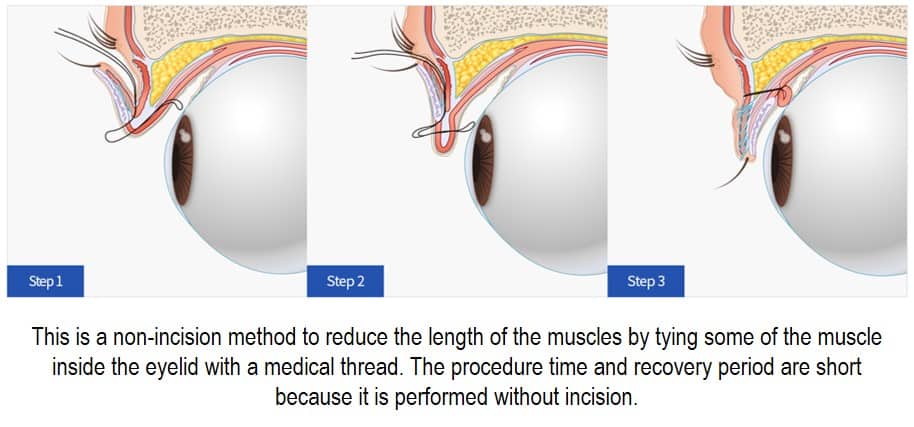
Droopy Eyelid Surgery In Singapore – Ptosis Correction

Procedure Time
1 – 2 Hours

Anaesthesia
Sedation

Recovery Period
10 – 14 Days

Stitch Removal
Not Required or
7 Days Post-op
What Is Droopy Eyelid Surgery For Ptosis Correction?
Ptosis correction surgery, also known as droopy eye surgery, is a procedure that helps improve the patient’s eye shape by strengthening their eye-opening muscles. So, if the eye does not have enough muscle strength, a Ptosis surgery in Singapore can present a more spacious and distinct eye shape while creating a more attractive and clearer double eyelid. The surgery also allows the patients to open their eyes easily and prevent wrinkles that often result from habitual eyebrow-raising or squinting.
What Is Ptosis?
Ptosis, also called drooping eyelids or blepharoptosis, is when the upper eyelid’s border falls to a lower position than normal. This condition can sometimes interfere with vision when the droopy eyelid covers all or part of the pupil. The drooping of the upper eyelid (ptosis) is largely classified as a medical condition.
What Causes Ptosis?
There can be different reasons behind drooping eyelids. Most of the time, it could be caused by one of the following:
Aging
Ptosis is most commonly observed in older adults due to the natural aging process. As you age, the levator muscle responsible for naturally lifting the eyelid begins to stretch, which causes the eyelid to droop or fall.
Habits
Individuals who wear contact lenses, apply eye make-up frequently, or have a habit of rubbing the eye excessively, are more likely to experience droopy eyelids. These habits speed up skin aging and muscle laxity on the eyelids, contributing to an earlier onset of ptosis compared to those who abstain from such habits.
Congenital
People of all ages can be affected by ptosis. Some babies are sometimes born with it, though it is a rare condition. The most common cause of congenital ptosis is that the levator muscle does not develop properly in babies. Children with ptosis may also develop amblyopia, a condition commonly known as a lazy eye. This disorder can also restrict or delay their vision.
Trauma
Trauma to the eye area can cause damage to the eyelid muscles and result in ptosis eyelid. Standard LASIK or cataract surgery can sometimes cause ptosis due to the tendon or muscle being stretched. In certain cases, nerve, tendon, or muscle injury may cause ‘temporary’ droopy eyelid conditions and it may recover on its own. However, if it does not resolve over time, one may require Ptosis Correction Surgery.
Related to other medical conditions
In more severe cases, ptosis may be caused by serious medical conditions such as brain tumors, stroke, or cancer of the muscles or nerves. Neurological disorders that affect the muscles or nerves of the eyes such as myasthenia gravis can also cause ptosis. Ptosis or droopy eyelid surgery is often recommended to restore the eyelid function and one’s vision.


Symptoms of Ptosis
Besides sagging or drooping of one or both upper eyelids, other symptoms of droopy eyelid may include:
- may have extremely watery or dry eyes
- face may look tired or weary
- experience frequent migraines or headaches when the eyes are strained for long hours
- may need to tilt their heads back to see properly, even while having a conversation.
In persistent droopy eyelids cases, a doctor will attempt to first rule out any other underlying conditions before ascertaining if ptosis surgery is right for you.
Types of Ptosis
- Aponeurotic – When the muscle is detached because of aging, excessive rubbing or pulling of the eyelids.
- Mechanical – When the upper eyelid is weighed down by excessive skin, fat or the presence of a tumor, which contributes to the appearance of a droopy eyelid.
- Traumatic – When the eyelid muscle is weakened after an injury.
- Neurogenic – When the nerves to the muscle stop functioning normally.
- Myogenic – When the muscle is not functioning normally.
Who Is Droopy Eyelid Surgery Recommended For
Droopy Eyelid Correction Surgery is for anyone with:
- Sagging eyelids that cover more than 20% of their pupil
- Sagging eyelids that have excess skin
- Eyes that look tired regardless of any amount of rest
- Frequent headaches due to overworking of their brows and the forehead muscles to maintain their eyes open
- Those who want bigger and more awake looking eyes
Types Of Droopy Eyelid Surgery Methods
The choice of ptosis correction method depends on how severe the condition of the eyelids are.
Non-Incisional Droopy Eyelid Surgery

During this procedure, muscle length is decreased by tying part of the eyelid muscle with the help of a suture. The tightening effect created by a decrease in the muscle’s length enables the eyelids to rise higher when eyes are opened.
The best candidates for this technique are individuals with mild droopy eyelids. Its procedure time is 40 – 60 minutes and is done under local anesthesia or light sedation. The recovery period is seven days, and the stitches are removed seven days after the procedure.
Incisional Droopy Eyelid Surgery

For severe cases, incisional surgery is needed. In this technique, the overstretched eyelid muscle is trimmed and pinned upwards, resulting in a higher lift of the eyelids with opening the eyes. Excess skin and fat are also eliminated, and double eyelids are redefined.
It is done in candidates suffering from moderate to severe droopy eyelids. The procedure typically takes 60 – 90 minutes to complete and is done under light sedation. The recovery period is 10 – 14 days, and stitches are removed after seven days of the procedure.
Frontalis Suspension Technique
In case when the levator functions are very weak, tightening or shortening of levator muscle will not be helpful. In such conditions, the frontalis suspension technique is used.
In this method, the eyelid tissue is connected to the frontalis muscle, located over the eyebrows, with the help of sutures. The sutures work like the suspension cables of the bridge. The forehead (frontalis) muscle acts as a substitute for the levator muscles.
Comparing Droopy Eyelid Surgery Techniques
Here is a quick comparison of both the ptosis eyelid surgery techniques used for correcting droopy eyelids.
Non-incisional Droopy Eyelid Correction
Candidate: Mild to moderate droopy eyelids
Surgical Method: Tighten eyelid muscles, redefine double eyelids
Procedure time: 40 – 60 minutes
Anaesthesia: Local anaesthesia or light sedation
Recovery period: 7 days
Stitch removal: Not required
Incisional Droopy Eyelid Correction
Candidate: Moderate to severe droopy eyelids
Surgical Method: Tighten muscles, get rid of excess skin and fat, and redefine double eyelids
Procedure time: 60 – 90 minutes
Anaesthesia: Light sedation
Recovery period: 10 – 14 days
Stitch Removal: 7 days after procedure
What To Expect From Ptosis Correction in Singapore
Turn sleepy eyes into greater and more brilliant looking eyes
Ptosis correction helps to create a more appealing eye shape by expanding eye height and pupil exposure. Those changes can have an impact in the eye shape and size, resulting in more alluring and bigger looking eyes. The improvements also make one appear more alert and well rested.
Reduce the dependence on the brow muscles and slow down new arrangement of forehead wrinkles
Ptosis correction reinforces the levator (eye-opening) muscles. The correction surgery restores the eyelid muscle functions, allowing eyelid movements to be controlled using the levator muscles rather than relying on other muscles groups around the forehead area. This significantly lessens dependency and strain on forehead muscles, preventing development of wrinkles from compensatory eyebrow-raising or habitual squinting.
Experience improvements in vision
Other than improving the appearance, droopy eyelid correction reestablishes the field of vision and reduce the feeling of heaviness on the eyelid. Most patients are able to see better, feel more youthful and subsequently improving their personal satisfaction.
Recreate double eyelids while fixing droopy eyelids in one procedure
Droopy eyelids cause double eyelid crease to become less defined as the eyelid ages and sags. The droopy eyelid procedure can fix the functional aspects of the eye, as well as recreate a neat and defined double eyelid crease, solving two problems at once.
Achieve a more rejuvenated and younger look
Most patients looking for eyelid surgery are interested in improving their appearance. This is one of the main benefits of the procedure. The plastic surgeon can remove some of the excess skin that is present. Removal of excess skin will improve the appearance of wrinkles on the upper eyelid and eradicate excess skin drooping over the eye which may make them appear smaller.
If puffiness is present on the upper eyelids, the surgeon can often correct that in the same procedure. Removal of excess fat tissues takes away that heavy or stuffy look. It also restores a tauter and flat upper eyelid contour, a characteristic which many associate with youth and beauty.
Improve Self-Esteem
It’s not uncommon for people to put a lot of focus on their appearance. Even if one believes in the mantra, “beauty is only skin deep”, they may not feel great about themselves when they observe their flaws in the mirror.
While eyelid surgery isn’t going to correct deep-seated psychological issues, it can certainly turn back to clock and return a more youthful appearance that may contribute to a person’s loss of self-esteem.
Considering Droopy Eyelid Surgery at Dream Singapore? Get in touch today and our medical staff will help you understand the procedure right from the start to end. We will also guide you in selecting the appropriate Ptosis eyelid surgery techniques for you.
What To Expect Before Ptosis Correction Surgery
Here are some things to take note before you consider ptosis surgery in Singapore:
- The process typically begins with a consultation with your surgeon, where they will assess the severity of your ptosis and discuss your goals and expectations. They will also evaluate your overall eye health to ensure you are a suitable candidate for the ptosis surgery.
- Expect to undergo a thorough medical evaluation, which may include eye tests, measurements, and potentially photographs of your eyelids. This evaluation helps the surgeon plan the most appropriate surgical technique.
- Your surgeon will provide specific pre-operative instructions, including guidelines to take note of before and after the surgery, which are essential for a safe procedure and to achieve your desired results.
Recovery From Ptosis Surgery
Following your ptosis correction surgery, you will likely experience some bruising and swelling, which should subside within one week to ten days. Postoperative pain is also expected, but it can be managed with oral painkillers. After this period, the majority of patients are able to resume their daily routines.
A follow-up appointment is also scheduled to examine your progress. Your doctor will remove the sutures after one week. During your recovery phase, you will get prescribed eye ointments and drops to lubricate your eyes.
You will notice clearer definement and proper repositioning of the eyelids within 4-12 weeks.
Dr Vincent Yeow’s Approach To Ensure the Optimal Results
There are a few important points to bear in mind when approaching ptosis surgery:
1. Proper assessment and diagnosis
It’s important to determine the real cause, as well as severity of the ptosis. A good assessment informs the plastic surgeon on what he/she should do to achieve the desired eyelid height while balancing aesthetic considerations, for better satisfaction.
2. Correct surgical procedure
Each surgical technique is tailored based on ptosis severity; each technique affords a different level of access to the levator muscle. Applying the correct surgical procedure ensures that the correct level of muscle correction is made.
3. Proper surgical technique and dissection
Given the limitations of each surgical technique, an experienced surgeon adapts their approach based on each patient’s unique problem areas, and knows how best to make and stitch up incisions.
4. Minimal surgical duration
A quicker surgery means less bruising and a more comfortable experience. It also means that recovery will be faster, resulting in a better surgical outcome.
Frequently Asked Questions (FAQ) about Droopy Eyelid Surgery (Ptosis)
Benefits of Ptosis Correction
Functional Improvements after ptosis surgery:
- Unobstructed vision
- No need to raise eyebrows or to tilt the head back to see
- No more headaches related to excessive use of forehead muscles to open the eyes
Aesthetic Improvements after ptosis surgery:
- Appearance of looking more awake and “well-rested”
- Bigger-looking eyes
- Creation or redefinition of eyelid crease
- Patients may also choose to undergo surgery for aesthetic reasons.
Any ptosis treatment will be customized based on:
- The severity of the ptosis
- Your desired aesthetic outcome
Are There Any After-Care Tips That I Should Follow?
Like any other cosmetic surgery procedure, there will be precautionary steps to be taken after undergoing ptosis correction surgery to ensure optimum good recovery. The following are some post-operative tips:
- Avoid excessive exposure to the sun to protect the delicate skin of your eyelid
- Do not rub your eyes after the surgery
- Make sure you complete the course of medications to prevent any infections and complications
- Apply cold compresses the next day after ptosis correction surgery to reduce swelling
- Do not forget to get balanced nutrition and rest to accelerate wound healing and recovery
- Avoid any strenuous activity for a week or two
Can Droopy Eyelid Surgery Make My Eyes Look Bigger?
Yes! Ptosis eyelid correction or droopy eyelid surgery removes the loose, saggy skin and soft tissue around the eyelids and tightens the eyelid muscles. Clinical studies and post-surgical trials have shown this procedure to be effective and it allows your eyes to open wider and make them appear bigger.
What Are The Risks And Complications With Ptosis Correction Surgery?
When performed by a certified plastic surgeon, ptosis surgery, in general, has a high success rate of 95% for treating droopy or asymmetrical eyelids. This procedure comes with little downtime and a lower risk of infection. However, risks and complications may still arise in cases of improper surgical technique or the wrong diagnosis of the ptosis cause.
Some potential risks and complications that come with ptosis correction include the following:
- Injury to eye muscles
- Suture breaking
- Bleeding and infection
- Noticeable scarring
- Excessive tearing
- Eyelid asymmetry
Will Health Insurance Cover Droopy Eyelid Surgery?
You can claim droopy eyelid surgery fees from your insurer in certain cases in which eyelid drooping is causing functional abnormality (such as blocking of field of vision). The doctor will thoroughly examine your eyes and label it as a medical condition that needs surgical correction.
Ptosis is considered a medical condition in Singapore. Therefore, droopy eyelid surgery is subsidized by most health insurance companies.
To get a diagnosis for upper eyelid ptosis, you will be advised to undergo a margin reflex distance (MRD) test. Your health insurance company will require MRD certification before qualifying you eligible for insurance claims.
What Is The Average Cost Of Ptosis Surgery in Singapore?
The average cost of ptosis correction in Singapore ranges from $7,000 to $16,000 depending on the type of surgery and the severity of your condition. However, the costs may also vary depending on the following factors:
- The surgeon’s fee
- The types of ptosis correction techniques
- Operating facilities’ fee
- Anaesthetist’s fee
- Medications prescribed
Are The Results Permanent?
In most cases, the results of ptosis correction surgery are permanent. However, 10% of the patients may complain of a redeveloped ptosis again in the future. In such cases, revision surgery will be required.
How Big Will My Scar Be?
It is very unlikely for the suture method to leave a scar on the eyelid.
The surgeons use thin sutures to close the wound and also prescribe an anti-scar cream to inhibit the scar formation. The initial scarring will disappear completely if you diligently apply the scar gel.
The incision method will leave a small scar; however, it will also blend in with the skin and soft tissue within 4 to 6 months.
